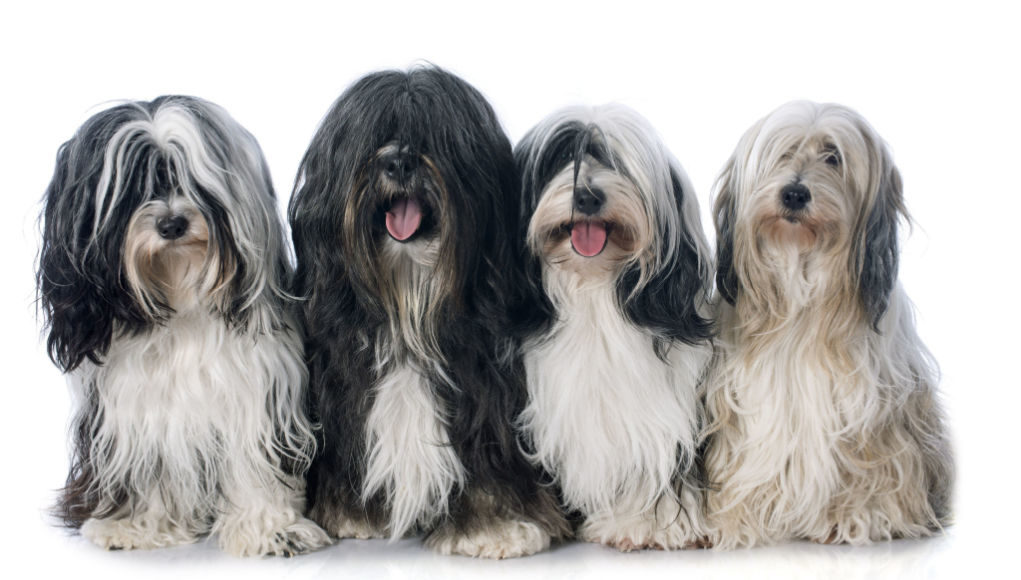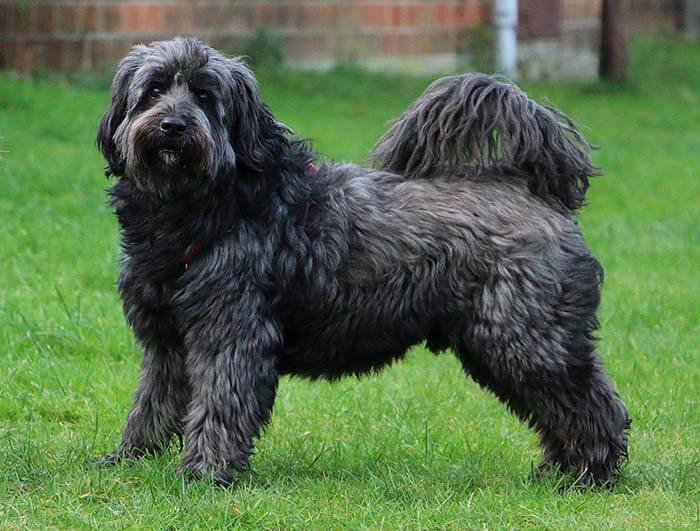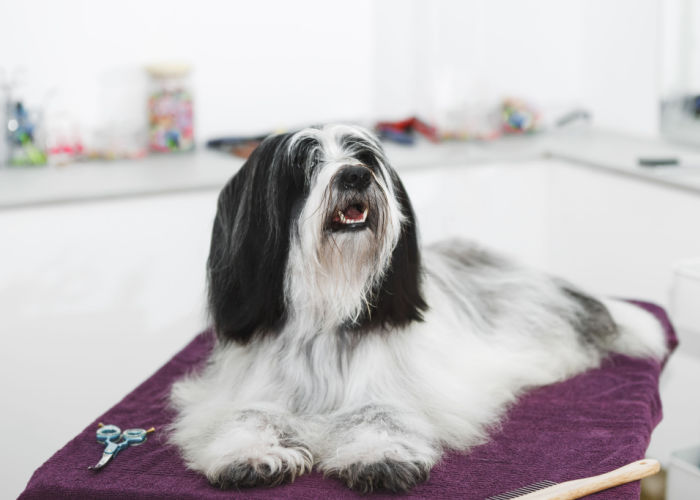Table of Contents
- Tibetan Terrier Dog Breed: An Overview
- Tibetan Terrier Dog Breed: History
- Tibetan Terrier Dog Breed: Traits and Characteristics
- Tibetan Terrier Dog Breed: Personality and Temperament
- Tibetan Terrier Dog Breed: Care Needs
- Tibetan Terrier Dog Breed: Possible Health Issues
- Tibetan Terrier Dog Breed: Fun Facts!
- FAQs on Tibetan Terrier Dog Breed
- Tibetan Terrier Dog Breed – Final Thoughts
Did you know that Tibetan Terriers are not precisely Terrier, despite their name?
Tibetan Terriers actually belong to the Non-Sporting Breed Group. But because of their similarities in appearance with terrier breeds, they were named terriers, too.
A case of mistaken identity? Perhaps. But this only makes them more interesting!
In this article, let's get to know Tibetan Terriers—their history, traits and characteristics, personality and temperament, and what makes this loyal, affectionate, and sensitive mid-size dog unique and special among the others.
Tibetan Terrier Dog Breed: An Overview
The Terrier breed group is known as a hunting breed, but Tibetan Terriers are actually different.
They are more of a companion breed who'd love to be the family watchdog but won't exactly go hunting with you.
But some of them enjoy the occasional hiking with their favorite people, though.
Tibetan Terriers typically stand 14 to 17 inches tall from the shoulders and weigh 18 to 30 pounds. Female Tibetan Terriers are slightly smaller than male Tibetan Terriers in comparison.
When cared for properly, this breed can reach up to 15 to 16 years lifespan.
According to the American Kennel Club's full breed standard, Tibetan Terriers are medium-sized dogs characterized by their protective double coat and unique foot construction.
But despite their compact size, you'd be surprised at how agile they can get.
Their size also allows them to be adaptable in whatever living conditions—whether in an apartment setting or a full-on house with a backyard. (Just not outside!)
As long as they're in the presence of their beloved humans, they should be fine.
Tibetan Terrier Dog Breed: History
As their name suggests, this breed originally came from the snowy and mountainous terrain of Tibet.
They were considered the Holy Dogs of Tibet, perhaps because of their association with Buddhist monks and the Dalai Lama (spiritual leader.)
Locally, they are called Tsang Apso or Dhoki Apso which literally translates to “the shaggy, bearded, outdoor dog.”
Tibetan Terriers were historically considered a good luck charm. They were only gifted and not bought.
Through this practice, an English doctor named Dr. Agnes Greig was gifted a white and gold female dog in 1922 after performing a successful operation on a Tibetan patient.
She brought the dog home to England and named her “Bunti.”
After acquiring a male one named “Rajah,” the first litter was finally born in 1924 but they were still known then as Lhasa Terriers. (And yes, Westerners were responsible for naming them as Terrier!)
They were only named Tibetan Terriers in 1930 by the Kennel Club of India and were recognized by The Kennel Club of the United Kingdom in 1937.
In 1956, this breed was carried over to the United States by Dr. Henry and Alice Murphy of Great Falls, Virginia.
They were later on recognized and classified by the American Kennel Club as non-sporting dogs in 1973.
Tibetan Terriers are an ancient breed and they were said to have contributed to the development of other similar-looking Asian dogs like the Lhasa Apso, Shih Tzu, and Tibetan Spaniel among others.
Tibetan Terrier Dog Breed: Traits and Characteristics
Any color or combination of colors is actually accepted as the standard for Tibetan Terriers.
They usually come in a wide variety of colors and patterns that are mainly white, gold, tricolor, brindle, silver, and black, among others.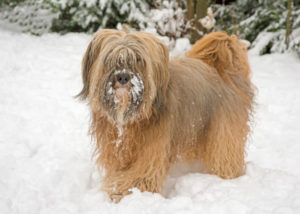
Tibetan Terriers are also protected by double coats of fur.
Their undercoat is soft and wooly, while the topcoat is either wavy or straight.
It also grows long, usually up to the ankle, and a natural part can be seen along their backs.
They are considered hypoallergenic, making them the perfect companion dog for people with allergies.
However, they are actually medium shedders but they lose hair the way we, humans lose ours.
Their shaggy fur usually covers their face and eyes, and their tails are curled forward over their backs.
A Tibetan Terrier usually has dark brown eyes that appear black sometimes. They also have dark rims around their eyes.
However, what's unique about Tibetan Terriers are their ‘snowshoe' feet.
Their feet are large, round, and flat, giving them the perfect traction for the snowy and mountainous terrain of where they originally came from.
The paws are thick, and there usually is hair in between the toes and pads to protect them from the cold. It really looks like they are born with built-in snow shoes!
Tibetan Terrier Dog Breed: Personality and Temperament
To their family, Tibetan Terriers can be the sweetest, most loyal companion.
They love the presence of their humans so much that they can get separation anxiety just by being left alone even just for a few hours.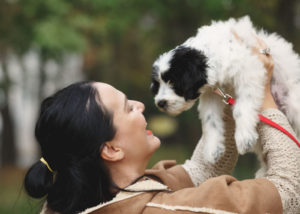
They'd surely entertain you with their goofy sense of humor.
And because they can be sensitive too, they can offer you a comforting nudge or cuddle whenever they sense you need one.
The Tibetan Terrier is also highly intelligent. They are easy to train especially by using positive reinforcement and treats.
But inasmuch as they can be affectionate to their family, they also have the tendency to be cautious or reserved to strangers.
The American Kennel Club even listed extreme shyness as a fault for Tibetan Terriers.
However, they'd still shamelessly bark at anything suspicious, true to their watchdog status.
But despite this, they can still get along well with other pets and older children. Younger children are fine too, but the Tibetan Terrier might be too timid for active toddlers.
Beware of a bored Tibetan Terrier, though. They can be an escape artist when they want to!
Tibetan Terrier Dog Breed: Care Needs
Grooming Needs
Daily brushing is the best way to go for Tibetan Terriers especially if you want to keep their long locks shiny and tangle-free.
Because of their dense double coat, they are prone to matting. It's important to brush them from root to tip to make sure there are no matted hairs hiding underneath.
Pay extra attention to the hair around their ears, belly, legs, and tails as those are the most prone to matting. You'd also want to regularly trim the hairs in between their toes.
Expert Tibetan Terrier owners also suggest using a spray bottle to mist the coat with water and conditioner as you brush. You can also use detangling sprays if you have one.
This may sound like a lot so it's understandable why some owners prefer clipping their pet's hair short for easier grooming.
But whatever their coat lengths are, you'd still want to bathe them at least once a month (or maybe more if they like playing outdoors!)
Of course, dental hygiene and nail care are also equally important.
As with other breeds, it's best to brush their teeth at least 2 or 3 times a week and have their nails trimmed at least once a month.
Check out our comprehensive guide on how to groom double-coated dogs.
Feeding Needs
High-quality dog food is necessary to keep your Tibetan Terrier well-fed and healthy whether it be commercially available or prepared at home.
Just be cautious though, because this breed has the tendency to gain excess weight.
The usual recommended daily amount is 1 1/8 cups to 1 3/8 cups of dog food, divided into 2 meals. And be careful about giving them too many treats!
It's best, of course, to speak to your veterinarian. He or she can recommend the type of food your dog requires depending on his age and condition.
Training Needs
Tibetan Terriers aren't the most energetic dog you'll meet but they still need a fair amount of exercise daily.
Don't worry though, ‘coz a 15-minute walk should suffice (or longer if you both are up for it!)
Basic obedience training can also start as early as the 7th week. You may want to focus on discouraging excessive barking as Tibetan Terriers have this tendency due to their watchdog history.
Same with other dogs, early socialization is key to making them well-rounded dogs.
Training should always be fun, consistent, and mentally stimulating for them. Positive reinforcement techniques such as praise, play, and food rewards also prove to be effective in training them.
Tibetan Terrier Dog Breed: Possible Health Issues
Eye Problems
Because of their long hair that mostly covers their eyes, it's no wonder eye problems are one of the things to watch out for in a Tibetan Terrier.
It could easily cause their eyes irritation if not properly trimmed or clipped, and could eventually lead to a Cataract, among others.
However, some inherited eye problems Tibetan Terriers could get are Lens Luxation (improper placement of the lens in the eye) or Progressive Retinal Atrophy (a degenerative eye disorder that leads to blindness.)
Hip Dysplasia
Although Hip Dysplasia is most common in large breeds, medium size dogs like Tibetan Terriers can also suffer from this.
Another inherited disorder, Hip Dysplasia happens when the ball and joint of the hips don't form or develop properly, resulting in deterioration and dysfunction.
Clinical signs may be evident but only in some cases. Treatment and therapy are important as this could later cause Arthritis if not addressed immediately.
Hypothyroidism
Known as “underactive thyroid,” Hypothyroidism has something to do with a dog's thyroid's inability to produce enough hormones which eventually can cause multiple health problems.
This is a common endocrine disorder in dogs. Early symptoms may show as lethargy, weight gain, and changes in hair coat and skin.
Luxating Patella
Another bone problem that can happen to Tibetan Terriers is the Luxating Patella. Patella is the scientific name for our kneecaps, while the term Luxating means out of place or dislocated.
Therefore, it is a condition where the kneecap pops out of its normal location.
Good thing, though, that this is a non-life threatening condition, and dogs can recover from it with proper treatment.
The Tibetan Terrier Club of America suggests several tests be done on this breed's litter to ensure the health of the puppies. Those are:
- Hip Evaluation
- Neuronal Ceroid Lipofuscinosis (NCL) DNA Test
- Ophthalmologist Evaluation
- Primary Lens Luxation
- Other DNA tests as recommended by experts
Tibetan Terrier Dog Breed: Fun Facts!
- This breed is among the breed of dogs favored by Buddhist monks and the Dalai Lama in Tibet–no wonder they're called “The Holy Dog of Tibet!”
- Tibetan Terriers are historically considered good luck charms—selling and mistreating them was believed to bring misfortune.
- They have existed for approximately 2,000 years and originated from a region in Tibet known as the “Lost Valley.”
- Despite being part of the non-sporting group, they were once considered herders and flock guardians in Tibet.
- Downtown Abbey's Hugh Bonneville and UK TV Presenter Clare Balding are known Tibetan Terrier lovers.
FAQs on Tibetan Terrier Dog Breed
Is Tibetan Terrier a good family dog?
Yes! Tibetan Terriers will make for a good family dog since they are now bred as companions and watchdogs.
They are loyal and affectionate to their family, and their calm demeanor and intelligence make them highly trainable.
Tibetan Terriers are also exceptional for their sweet and sensitive nature.
One good thing to remember though: they are used to human presence so much that they'd get anxious if left alone quite often or for too long!
Do Tibetan Terriers like to swim?
Tibetan Terriers can hike on slopey mountains, sure, but water activities aren't really their thing. Generally, this breed doesn't like swimming.
However, since dogs are individuals too, you may have seen or heard of some Tibetan Terriers who actually enjoy a splash in the pool.
Do Tibetan Terriers like hot weather?
Tibetan Terriers came from the cold climate of Tibet so they are really built for snowy and low-temperature areas.
Good thing that their double coat of fur allows them to be adaptable to whatever living condition there is–including hot weather!
They do better in the heat than most breeds but owners should always be cautious about too much heat in any dog breed.
Tibetan Terrier Dog Breed – Final Thoughts
Tibetan Terriers are one of the best mid-size dog breeds you can get for the whole family.
If you have too much spare time on your hands, they can surely keep you busy—daily brushing of those majestic locks will not only make sure they stay glorious, it makes for the perfect bonding moment too!
Not only you'll get yourself an adorable-looking dog, but you'll also get one with the looks, personality and temperament, and traits and characteristics that are well-loved by many across the globe.
They'll surely bring the family nothing but good luck and good vibes all the time!


